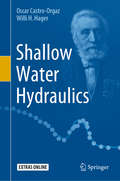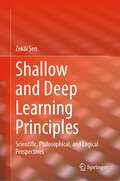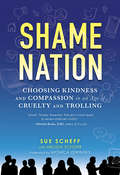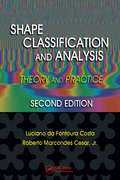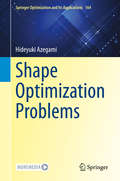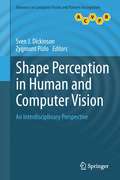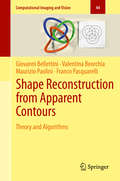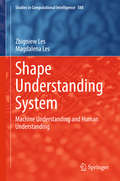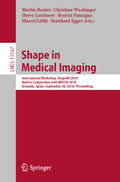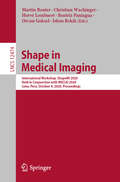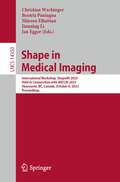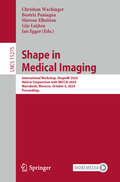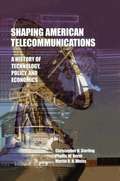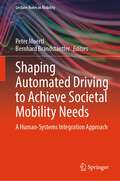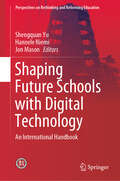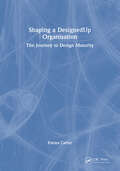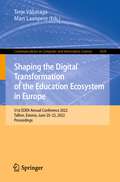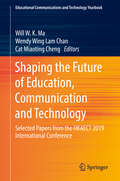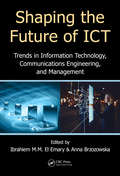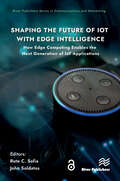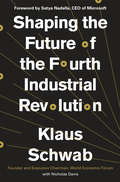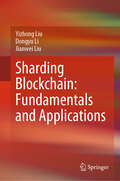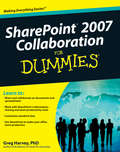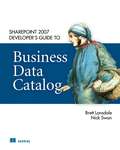- Table View
- List View
Shallow Water Hydraulics
by Willi H. Hager Oscar Castro-OrgazThis book presents the theory and computation of open channel flows, using detailed analytical, numerical and experimental results. The fundamental equations of open channel flows are derived by means of a rigorous vertical integration of the RANS equations for turbulent flow. In turn, the hydrostatic pressure hypothesis, which forms the core of many shallow water hydraulic models, is scrutinized by analyzing its underlying assumptions. The book’s main focus is on one-dimensional models, including detailed treatments of unsteady and steady flows. The use of modern shock capturing finite difference and finite volume methods is described in detail, and the quality of solutions is carefully assessed on the basis of analytical and experimental results.The book’s unique features include:• Rigorous derivation of the hydrostatic-based shallow water hydraulic models• Detailed treatment of steady open channel flows, including the computation of transcritical flow profiles• General analysis of gate maneuvers as the solution of a Riemann problem• Presents modern shock capturing finite volume methods for the computation of unsteady free surface flows• Introduces readers to movable bed and sediment transport in shallow water models• Includes numerical solutions of shallow water hydraulic models for non-hydrostatic steady and unsteady free surface flowsThis book is suitable for both undergraduate and graduate level students, given that the theory and numerical methods are progressively introduced starting with the basics. As supporting material, a collection of source codes written in Visual Basic and inserted as macros in Microsoft Excel® is available. The theory is implemented step-by-step in the codes, and the resulting programs are used throughout the book to produce the respective solutions.
Shallow and Deep Learning Principles: Scientific, Philosophical, and Logical Perspectives
by Zekâi ŞenThis book discusses Artificial Neural Networks (ANN) and their ability to predict outcomes using deep and shallow learning principles. The author first describes ANN implementation, consisting of at least three layers that must be established together with cells, one of which is input, the other is output, and the third is a hidden (intermediate) layer. For this, the author states, it is necessary to develop an architecture that will not model mathematical rules but only the action and response variables that control the event and the reactions that may occur within it. The book explains the reasons and necessity of each ANN model, considering the similarity to the previous methods and the philosophical - logical rules.
Shame Nation: The Global Epidemic Of Online Hate
by Melissa Schorr Sue Scheff Monica Lewinksy"Engaging, sharp, and important — Shame Nation will inspire you to open your eyes and be better." — Theresa Payton, CEO of Fortalice Solutions and Deputy Director of Intelligence on CBS' HuntedIn today's digitally driven world, disaster is only a click away. A rogue tweet could bring down a business; an army of trolls can run a celebrity off-line; and virtual harassment might cause real psychological damage. Shame Nation is the first book to both study the fascinating phenomenon of online shaming, and offer practical guidance and inspiring advice on how to prevent and protect against cyber blunders and faceless bullies. Author and acclaimed Internet safety expert Sue Scheff unveils all sides of an issue that it only becoming more relevant day by day while drawing from the expertise of other top professionals spanning fields including law, psychology, and reputation management.From damning screenshots to revenge porn, Shame Nation shines a light on the rising trend of an online shame culture and empowers readers to take charge of their digital lives.
Shape Classification and Analysis: Theory and Practice, Second Edition (Image Processing Series)
by Luciano da Costa Roberto Marcond Cesar, Jr.Because the properties of objects are largely determined by their geometric features, shape analysis and classification are essential to almost every applied scientific and technological area. A detailed understanding of the geometrical features of real-world entities (e.g., molecules, organs, materials and components) can provide important clues about their origin and function. When properly and carefully applied, shape analysis offers an exceedingly rich potential to yield useful applications in diverse areas ranging from material sciences to biology and neuroscience.Get Access to the Authors’ Own Cutting-Edge Open-Source Software Projects—and Then Actually Contribute to Them Yourself! The authors of Shape Analysis and Classification: Theory and Practice, Second Edition have improved the bestselling first edition by updating the tremendous progress in the field. This exceptionally accessible book presents the most advanced imaging techniques used for analyzing general biological shapes, such as those of cells, tissues, organs, and organisms. It implements numerous corrections and improvements—many of which were suggested by readers of the first edition—to optimize understanding and create what can truly be called an interactive learning experience. New Material in This Second Edition Addresses Graph and complex networks Dimensionality reduction Structural pattern recognition Shape representation using graphs Graphically reformulated, this edition updates equations, figures, and references, as well as slides that will be useful in related courses and general discussion. Like the popular first edition, this text is applicable to many fields and certain to become a favored addition to any library. Visit http://www.vision.ime.usp.br/~cesar/shape/ for Useful Software, Databases, and Videos
Shape Optimization Problems (Springer Optimization and Its Applications #164)
by Hideyuki AzegamiThis book provides theories on non-parametric shape optimization problems, systematically keeping in mind readers with an engineering background. Non-parametric shape optimization problems are defined as problems of finding the shapes of domains in which boundary value problems of partial differential equations are defined. In these problems, optimum shapes are obtained from an arbitrary form without any geometrical parameters previously assigned. In particular, problems in which the optimum shape is sought by making a hole in domain are called topology optimization problems. Moreover, a problem in which the optimum shape is obtained based on domain variation is referred to as a shape optimization problem of domain variation type, or a shape optimization problem in a limited sense. Software has been developed to solve these problems, and it is being used to seek practical optimum shapes. However, there are no books explaining such theories beginning with their foundations.The structure of the book is shown in the Preface. The theorems are built up using mathematical results. Therefore, a mathematical style is introduced, consisting of definitions and theorems to summarize the key points. This method of expression is advanced as provable facts are clearly shown. If something to be investigated is contained in the framework of mathematics, setting up a theory using theorems prepared by great mathematicians is thought to be an extremely effective approach. However, mathematics attempts to heighten the level of abstraction in order to understand many things in a unified fashion. This characteristic may baffle readers with an engineering background. Hence in this book, an attempt has been made to provide explanations in engineering terms, with examples from mechanics, after accurately denoting the provable facts using definitions and theorems.
Shape Perception in Human and Computer Vision: An Interdisciplinary Perspective
by Sven J. Dickinson Zygmunt PizloThis comprehensive and authoritative text/reference presents a unique, multidisciplinary perspective on Shape Perception in Human and Computer Vision. Rather than focusing purely on the state of the art, the book provides viewpoints from world-class researchers reflecting broadly on the issues that have shaped the field. Drawing upon many years of experience, each contributor discusses the trends followed and the progress made, in addition to identifying the major challenges that still lie ahead. Topics and features: examines each topic from a range of viewpoints, rather than promoting a specific paradigm; discusses topics on contours, shape hierarchies, shape grammars, shape priors, and 3D shape inference; reviews issues relating to surfaces, invariants, parts, multiple views, learning, simplicity, shape constancy and shape illusions; addresses concepts from the historically separate disciplines of computer vision and human vision using the same "language" and methods.
Shape Reconstruction from Apparent Contours
by Giovanni Bellettini Valentina Beorchia Maurizio Paolini Franco PasquarelliMotivated by a variational model concerning the depth of the objects in a picture and the problem of hidden and illusory contours, this book investigates one of the central problems of computer vision: the topological and algorithmic reconstruction of a smooth three dimensional scene starting from the visible part of an apparent contour. The authors focus their attention on the manipulation of apparent contours using a finite set of elementary moves, which correspond to diffeomorphic deformations of three dimensional scenes. A large part of the book is devoted to the algorithmic part, with implementations, experiments, and computed examples. The book is intended also as a user's guide to the software code appcontour, written for the manipulation of apparent contours and their invariants. This book is addressed to theoretical and applied scientists working in the field of mathematical models of image segmentation.
Shape Understanding System
by Zbigniew Les Magdalena LesThis is the third book presenting selected results of research on the further development of the shape understanding system (SUS) carried out by authors in the newly founded Queen Jadwiga Research Institute of Understanding. In this book the new term Machine Understanding is introduced referring to a new area of research aiming to investigate the possibility of building machines with the ability to understand. It is presented that SUS needs to some extent mimic human understanding and for this reason machines are evaluated according to the rules applied for the evaluation of human understanding. The book shows how to formulate problems and how it can be tested if the machine is able to solve these problems.
Shape in Medical Imaging: International Workshop, ShapeMI 2018, Held in Conjunction with MICCAI 2018, Granada, Spain, September 20, 2018, Proceedings (Lecture Notes in Computer Science #11167)
by Martin Reuter Christian Wachinger Hervé Lombaert Beatriz Paniagua Marcel Lüthi Bernhard EggerThis book constitutes the proceedings of the Workshop on Shape in Medical Imaging, ShapeMI 2018, held in conjunction with the 21st International Conference on Medical Image Computing, MICCAI 2018, in Granada, Spain, in September 2018. The 26 full papers and 2 short papers presented were carefully reviewed and selected for inclusion in this volume. The papers discuss novel approaches and applications in shape and geometry processing and their use in research and clinical studies and explore novel, cutting-edge theoretical methods and their usefulness for medical applications, e.g., from the fields of geometric learning or spectral shape analysis.
Shape in Medical Imaging: International Workshop, ShapeMI 2020, Held in Conjunction with MICCAI 2020, Lima, Peru, October 4, 2020, Proceedings (Lecture Notes in Computer Science #12474)
by Martin Reuter Christian Wachinger Hervé Lombaert Orcun Goksel Islem Rekik Beatriz PaniaguaThis book constitutes the proceedings of the International Workshop on Shape in Medical Imaging, ShapeMI 2020, which was held in conjunction with the 23rd International Conference on Medical Image Computing and Computer Assistend Intervention, MICCAI 2020, in October 2020. The conference was planned to take place in Lima, Peru, but changed to a virtual format due to the COVID-19 pandemic. The 12 full papers included in this volume were carefully reviewed and selected from 18 submissions. They were organized in topical sections named: methods; learning; and applications.
Shape in Medical Imaging: International Workshop, ShapeMI 2023, Held in Conjunction with MICCAI 2023, Vancouver, BC, Canada, October 8, 2023, Proceedings (Lecture Notes in Computer Science #14350)
by Christian Wachinger Beatriz Paniagua Jan Egger Jianning Li Shireen ElhabianThis volume comprises the proceedings of the International Workshop, ShapeMI 2023, which took place alongside MICCAI 2023 on October 8, 2023, in Vancouver, British Columbia, Canada.The 23 selected full papers deal with all aspects of leading methods and applications for advanced shape analysis and geometric learning in medical imaging.
Shape in Medical Imaging: International Workshop, ShapeMI 2024, Held in Conjunction with MICCAI 2024, Marrakesh, Morocco, October 6, 2024, Proceedings (Lecture Notes in Computer Science #15275)
by Christian Wachinger Beatriz Paniagua Jan Egger Shireen Elhabian Gijs LuijtenThis book constitutes the proceedings of the International Workshop on Shape in Medical Imaging, ShapeMI 2024, which took place in Marrakesh, Morocco, on October 6, 2024, held in conjunction with MICCAI 2024. The 16 full papers included in this book were carefully reviewed and selected from 24 submissions. They focus on shape and spectral analysis, geometric learning and modeling algorithms, and application-driven research.
Shapes of Imagination: Calculating in Coleridge's Magical Realm
by George StinyVisual calculating in shape grammars aligns with art and design, bridging the gap between seeing (Coleridge's &“imagination&”) and combinatoric play (Coleridge's &“fancy&”).In Shapes of Imagination, George Stiny runs visual calculating in shape grammars through art and design—incorporating Samuel Taylor Coleridge's poetic imagination and Oscar Wilde's corollary to see things as they aren't. Many assume that calculating limits art and design to suit computers, but shape grammars rely on seeing to prove otherwise. Rules that change what they see extend calculating to overtake what computers can do, in logic and with data and learning. Shape grammars bridge the divide between seeing (Coleridge's &“imagination, or esemplastic power&”) and combinatoric play (Coleridge's &“fancy&”).Stiny shows that calculating without seeing excludes art and design. Seeing is key for calculating to augment creative activity with aesthetic insight and value. Shape grammars go by appearances, in a full-fledged aesthetic enterprise for the inconstant eye; they answer the question of what calculating would be like if Turing and von Neumann were artists instead of logicians. Art and design are calculating in all their splendid detail.
Shaping American Telecommunications: A History of Technology, Policy, and Economics (LEA Telecommunications Series)
by Christopher H. Sterling Phyllis W. Bernt Martin B.H. WeissShaping American Telecommunications examines the technical, regulatory, and economic forces that have shaped the development of American telecommunications services. This volume is both an introduction to the basic technical, economic, and regulatory principles underlying telecommunications, and a detailed account of major events that have marked development of the sector in the United States. Beginning with the introduction of the telegraph and continuing through to current developments in wireless and online services, authors Christopher H. Sterling, Phyllis W. Bernt, and Martin B.H. Weiss explain each stage of telecommunications development, examining the interplay among technical innovation, policy decisions, and regulatory developments.Offering an integrated treatment of the interplay among technology, policy, and economics as key factors defining the development of the telecommunications sector in the United States, this volume also provides:*background material to facilitate understanding of each sector;*contexts for many so-called "new" issues, problems, and trends, demonstrating origins from years or decades in the past; and*careful annotation, documentation, and reference tables to enable further research on the topics discussed.This unique multidisciplinary approach provides a balanced view of U.S. telecommunications history, in context with relevant economic, legal, social, and technical analyses. As such, it is essential reading for advanced students in telecommunications needing to understand how the telecommunications industry and service developed to its current form. The volume will also serve as a supplemental text in courses on telecommunications regulation, and it will be of value to professionals in the field seeking context and background for their daily work.
Shaping Automated Driving to Achieve Societal Mobility Needs: A Human-Systems Integration Approach (Lecture Notes in Mobility)
by Peter Moertl Bernhard BrandstaetterThis edited book describes novel human-systems integration approaches to improve acceptance, safety, and comfort of automated vehicles. Each chapter analyses different aspects in the development of automated driving systems such as: assessing needs and opportunities of specific user populations i.e. elderly drivers and truck drivers; creating fluid human-systems interactions in the vehicle to answer specific driver needs; developing an automated driving tutoring application; and identifying benefits of including road infrastructure sensors to support automated driving predictability. A detailed description of the assessment of the above-described solutions in real-world situations is also included. Written by both researchers and professionals, this book offers timely and practice-oriented information concerning the development of automated driving systems that better adapt to the users’ needs.
Shaping Future Schools with Digital Technology: An International Handbook (Perspectives on Rethinking and Reforming Education)
by Shengquan Yu Hannele Niemi Jon MasonThis book presents an overview of education technology and its use in schools, with a primary emphasis on best practices of technology enhanced learning; how new technologies such as mobile, augmented and wearable technologies affect instructional design strategies; and the content curriculum development process. Providing insights into the future of education and the upcoming pedagogies that will be applied in schools, it helps educators and other stakeholders make innovations for the new generations of learners in the 21st century.The use of emerging technologies such as mobile and ubiquitous technologies, context-aware technology, augment-reality, and virtual reality is contributing to making education adaptive and smarter. With the ever-changing technologies, how to equip teachers with these digital skills and transform their teaching style is also important to ensure that school education is more individualised and customised for students.Offering a global perspective with integrated practical cases, this timely book is of interest to educators, teachers, and education policymakers. And although most of the authors are from the academia, it provides non-experts with a novel view of what future schools will be like with the help of technology.
Shaping a DesignedUp Organisation: The Journey to Design Maturity
by Emma Carter“Emma Carter reveals how organizations can shift from tech-centric to design-led, creating meaningful experiences. Through case studies and practical frameworks, she demonstrates how scaling design isn’t about adding more designers but transforming how organizations think and operate. This essential guide helps leaders embed design thinking at every level, turning transformation into a continuous evolution.In Shaping a DesignedUp Organisation Emma Carter distills the essence of digital transformation: true progress lies in simplifying through design thinking, not adding complexity. Like a conductor harmonizing an orchestra, she shows how tech and design can work together to serve human needs. More than a book on shaping and scaling design, this is a vision for a more powerful, humane digital future—essential for those bridging technology and human experience.”—John Maeda, VP Engineering, Head of Computational Design / AI Platform, MicrosoftThe learnings gained from Shaping a DesignedUp Organisation will not only give design leaders a seat at the table, it’ll make them the smartest person at the table - creating influence, driving conversations for growth, and ultimately shaping their company into a ‘design mature’ organisation.But that’s not to say this book is strictly for design leaders. Tech leaders, product leaders and business leaders will come to see how business performance and design are intrinsically linked. You’ll gain intimate insights from leaders at world-leading organisations like Spotify, Disney, Airbnb, Monzo and frog and learn about a variety of frameworks and practical approaches to help your organisation reach design maturity with a human focus.And if you’re in an organisation not convinced by the value of design, you’ll learn how to translate the benefits of embedding design at every touchpoint in a way that’s meaningful, valuable and profitable to various stakeholders, creating an army of design advocates to future proof your organisation…and decrease its risk of becoming a dinosaur.
Shaping the Digital Transformation of the Education Ecosystem in Europe: 31st EDEN Annual Conference 2022, Tallinn, Estonia, June 20–22, 2022, Proceedings (Communications in Computer and Information Science #1639)
by Mart Laanpere Terje VäljatagaThis book constitutes refereed proceedings of the 31st Annual Conference on European Distance and E-Learning Network, EDEN 2022, held in Tallinn, Estonia, from June 20–22, 2022. The 11 full papers and 2 short papers presented in this volume were carefully reviewed and selected from a total of 78 submissions. The papers in the volume are organised according to the following topical headings: higher education; teachers’ professional development; digital competencies; inclusive education
Shaping the Future of Education, Communication and Technology: Selected Papers from the HKAECT 2019 International Conference (Educational Communications and Technology Yearbook)
by Will W. K. Ma Wendy Wing Lam Chan Cat Miaoting ChengThis book gathers selected papers from the Hong Kong Association for Educational Communications and Technology 2019 International Conference on the theme of “Shaping the Future of Education, Communication and Technology.” It contributes to a scholarly discussion that looks beyond what future media and technology can offer for education, and reflects on best practices and lessons learned from applying new media and technology in a wide range of fields. Scholars from educational technology, communication, and higher education share their research work in various formats such as empirical research, best-practice case studies, literature reviews, etc. The topics of the papers are divided into four main areas, including curriculum, pedagogy and instructional design; teaching and learning experiences with technology; online learning and open education resources; and communication and media. The book’s unique quality is its combination of perspectives and research work on communication, education and technology. Thus, it will encourage an interdisciplinary discourse and exchange concerning communication, new media, and educational practices.
Shaping the Future of ICT: Trends in Information Technology, Communications Engineering, and Management
by Ibrahiem M. M. El Emary and Anna BrzozowskaThe International Conference on Communications, Management, and Information Technology (ICCMIT’16) provides a discussion forum for scientists, engineers, educators and students about the latest discoveries and realizations in the foundations, theory, models and applications of systems inspired on nature, using computational intelligence methodologies, as well as in emerging areas related to the three tracks of the conference: Communication Engineering, Knowledge, and Information Technology. The best 25 papers to be included in the book will be carefully reviewed and selected from numerous submissions, then revised and expanded to provide deeper insight into trends shaping future ICT.
Shaping the Future of IoT with Edge Intelligence: How Edge Computing Enables the Next Generation of IoT Applications (River Publishers Series in Communications and Networking)
by John Soldatos Rute C. SofiaThis book presents the technologies that empower edge intelligence, along with their use in novel IoT solutions. Specifically, it presents how 5G/6G, Edge AI, and Blockchain solutions enable novel IoT-based decentralized intelligence use cases at the edge of the cloud/edge/IoT continuum. Emphasis is placed on presenting how these technologies support a wide array of functional and non-functional requirements spanning latency, performance, cybersecurity, data protection, real-time performance, energy efficiency, and more. The various chapters of the book are contributed by several EU-funded projects, which have recently developed novel IoT platforms that enable the development and deployment of edge intelligence applications based on the cloud/edge paradigm. Each one of the projects employs its own approach and uses a different mix of networking, middleware, and IoT technologies. Therefore, each of the chapters of the book contributes a unique perspective on the capabilities of enabling technologies and their integration in practical real-life applications in different sectors. The book is structured in five distinct parts. Each one of the first four parts focuses on a specific set of enabling technologies for edge intelligence and smart IoT applications in the cloud/edge/IoT continuum. Furthermore, the fifth part provides information about complementary aspects of next-generation IoT technology, including information about business models and IoT skills. Specifically: The first part focuses on 5G/6G networking technologies and their roles in implementing edge intelligence applications. The second part presents IoT applications that employ machine learning and other forms of Artificial Intelligence at the edge of the network. The third part illustrates decentralized IoT applications based on distributed ledger technologies. The fourth part is devoted to the presentation of novel IoT applications and use cases spanning the cloud/edge/IoT continuum. The fifth part discusses complementary aspects of IoT technologies, including business models and digital skills.
Shaping the Future of the Fourth Industrial Revolution: A Guide To Building A Better World
by Klaus Schwab Satya Nadella Nicholas DavisWorld Economic Forum Founder and Executive Chairman Klaus Schwab offers a practical companion and field guide to his previous book, The Fourth Industrial Revolution.Today, technology is changing everything--how we relate to one another, the way we work, how our economies and goverments function, and even what it means to be human. One need not look hard to see how the incredible advances in artificial intelligence, cryptocurrencies, biotechnologies, and the internet of things are transforming society in unprecedented ways. But the Fourth Industrial Revolution is just beginning, says Schwab. And at a time of such tremendous uncertainty and such rapid change, he argues it's our actions as individuals and leaders that will determine the trajectory our future will take. We all have a responsibility - as citizens, businesses, and institutions - to work with the current of progress, not against it, to build a future that is ethical, inclusive, sustainable and prosperous. Drawing on contributions from 200 top experts in fields ranging from machine learning to geoengineering to nanotechnology, to data ethics, Schwab equips readers with the practical tools to leverage the technologies of the future to leave the world better, safer, and more resilient than we found it.
Sharding Blockchain: Fundamentals and Applications
by Jianwei Liu Dongyu Li Yizhong LiuThis book presents a novel approach by decoupling the various modules of sharding blockchains and providing detailed insights into the functions and design methodologies of each key module. Previous sharding blockchain solutions suffered from tight coupling between functional modules, making it challenging to achieve optimal security, performance, and scalability. Building upon this foundation, the authors present a universal composable method for composing sharding blockchains in a flexible manner. Additionally, the authors propose a novel shard member configuration method that leverages proof-of-work and verifiable distributed randomness to guarantee that each shard maintains a sufficient proportion of honest nodes, preventing it from falling below the safety threshold. Furthermore, the authors offer a complete design methodology for creating secure and scalable sharding blockchains. This includes reducing the complexity of intra-shard transaction processing through aggregation-supported multi-signature. The authors ensure optimal sharding of computational, communication, and storage resources within a formal security framework. To facilitate flexible cross-shard transaction processing, the authors introduce a new cross-shard Byzantine fault tolerance protocol. Lastly, the authors explore practical applications of sharding blockchains in typical scenarios. In the context of zero-trust cloud-edge-end scenarios, the authors demonstrate how sharding blockchains enable scalable data cross-shard sharing. Simultaneously, the authors design a secure and universally applicable cross-domain device authentication scheme.
SharePoint 2007 Collaboration For Dummies
by Greg HarveyIf you're looking for a way to help your teams access what they need to know, work together, and get the job done, SharePoint can do just that. SharePoint 2007 Collaboration For Dummies shows you the easiest way to set up and customize SharePoint, manage your data, interact using SharePoint blogs and wikis, integrate Office programs, and make your office more productive. You'll learn what SharePoint can do and how to make it work for your business, understand the technical terms, and enable your people to collaborate on documents and spreadsheets. You'll even discover how to get SharePoint help online. Work with SharePoint's information-sharing and team productivity tools See how data is stored in lists and libraries and arrange access for your teams Use SharePoint's meeting workspaces and add the capability for virtual meetings online Create blogs where team members can share ideas and wiki libraries to keep information up to date Keep everything on track with task lists and workflows to assign and monitor projects and progress Integrate Word and Excel, or connect SharePoint to Outlook 2007 so you can access information from your inbox Use Office SharePoint Designer 2007 to create custom workflows for your SharePoint task lists With tips for designing the perfect SharePoint site and ideas about enhancing your team meetings with meeting workspaces, SharePoint 2007 Collaboration For Dummies helps you put this great collaboration tool to work right away. Note: CD-ROM/DVD and other supplementary materials are not included as part of eBook file.
SharePoint 2007 Developer's Guide to Business Data Catalog
by Brett Lonsdale Nick SwanThe data locked in your organization's systems and databases is a precious -- and sometimes untapped -- resource. The SharePoint Business Data Catalog makes it easy to gather, analyze, and report on data from multiple sources, through SharePoint. Using standard web parts, an efficient management console, and a simple programming model, you can build sites, dashboards, and applications that maximize this business asset.SharePoint 2007 Developer's Guide to Business Data Catalog is a practical, example-rich guide to the features of the BDC and the techniques you need to build solutions for end users. The book starts with the basics -- what the BDC is, what you can do with it, and how to pull together a BDC solution. With the fundamentals in hand, it explores the techniques and ideas you need to put BDC into use effectively in your organization. Purchase of the print book comes with an offer of a free PDF, ePub, and Kindle eBook from Manning. Also available is all code from the book. Knowledge of SharePoint Server and WSS is required."This book is an absolute must-have!"-Christina Wheeler, SharePoint Consultant, Summit 7 Systems" from experts who know the BDC inside and out."-Monty Grusendorf, Senior Web Developer, Bantrel "An excellent guide for working with the BDC."-Darren Neimke, Author of ASP.NET 2.0 Web Parts in Action"A one-stop guide for SharePoint BDC developers."-Prajwal Khanal, Senior Software Engineer, D2HawkeyeServices Pvt. Ltd.
